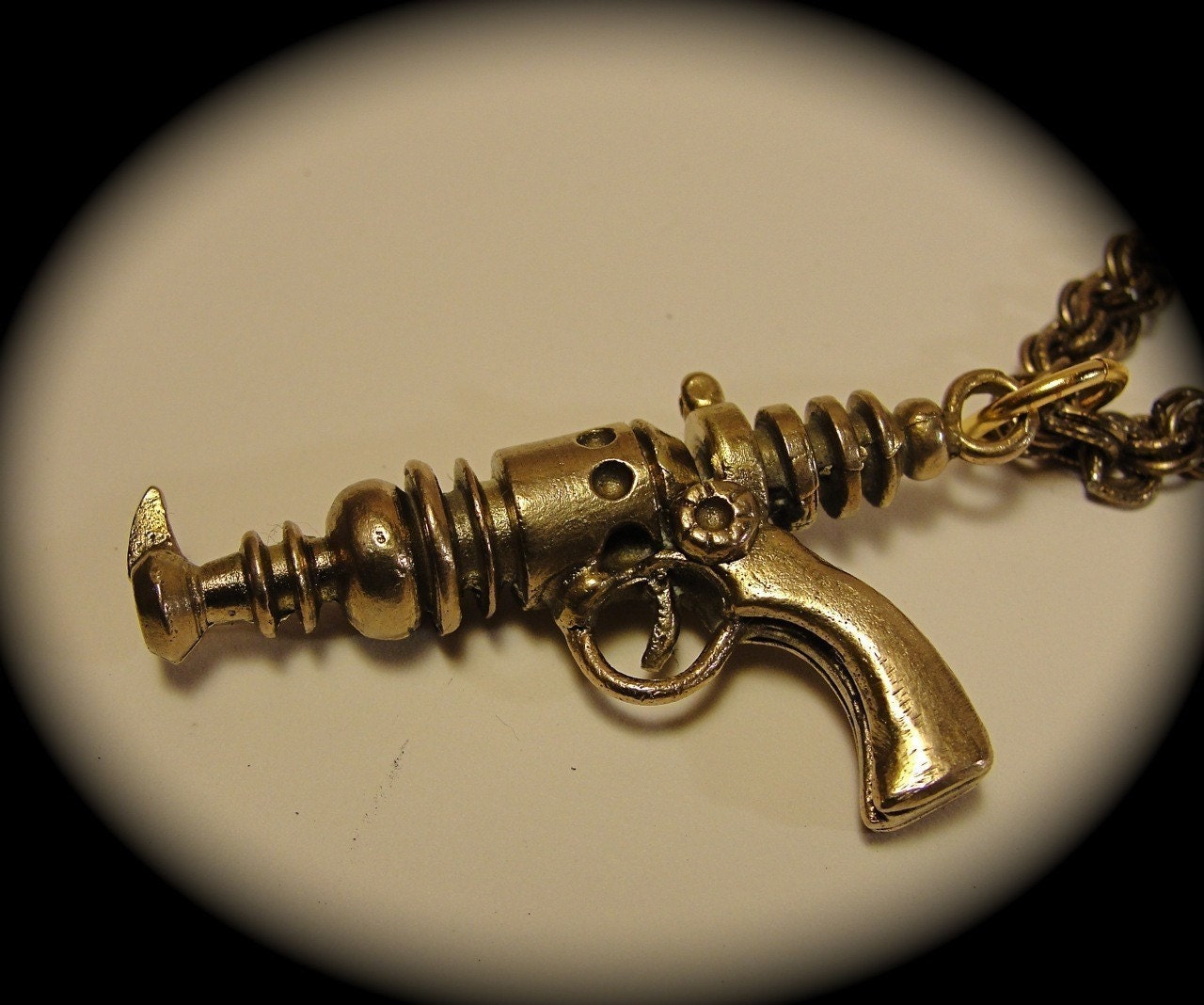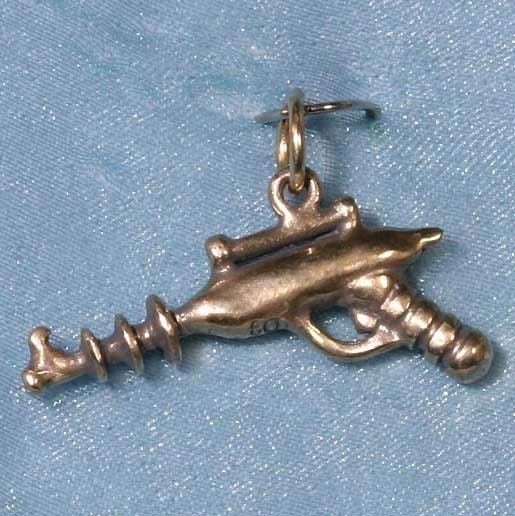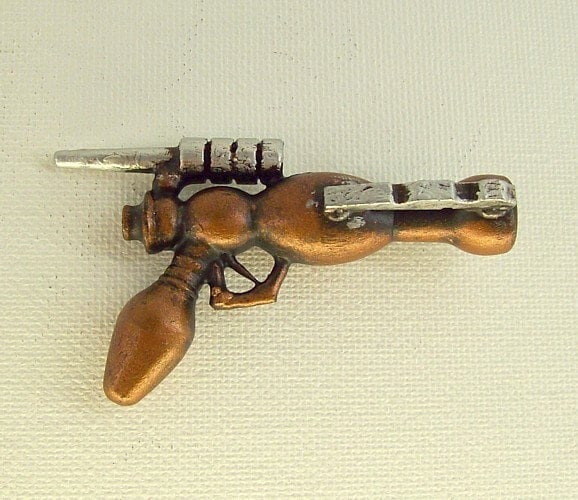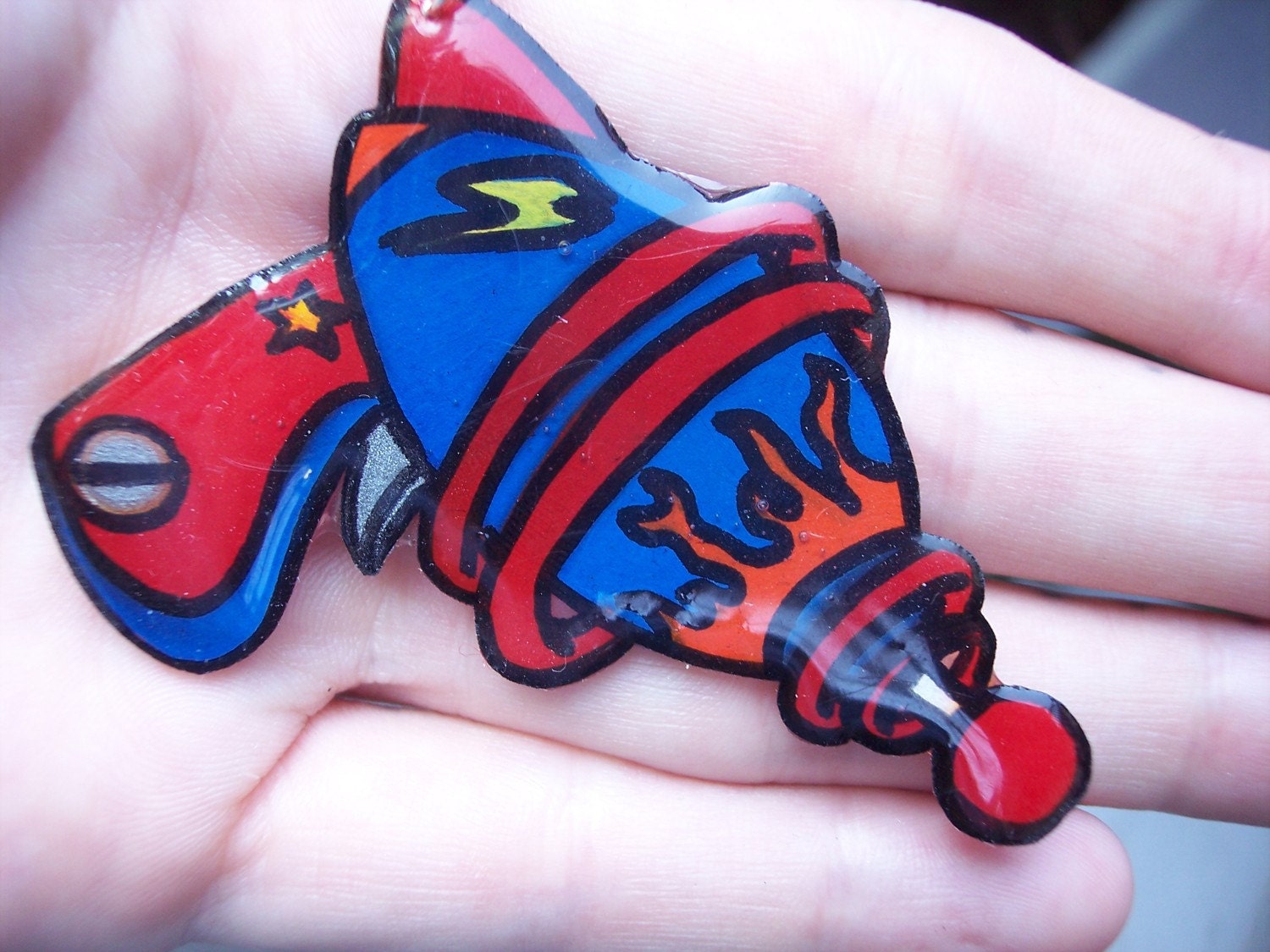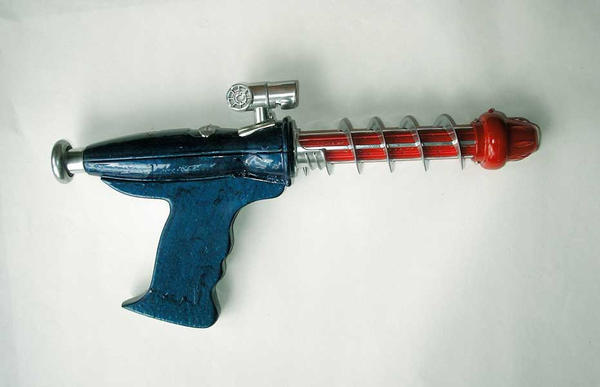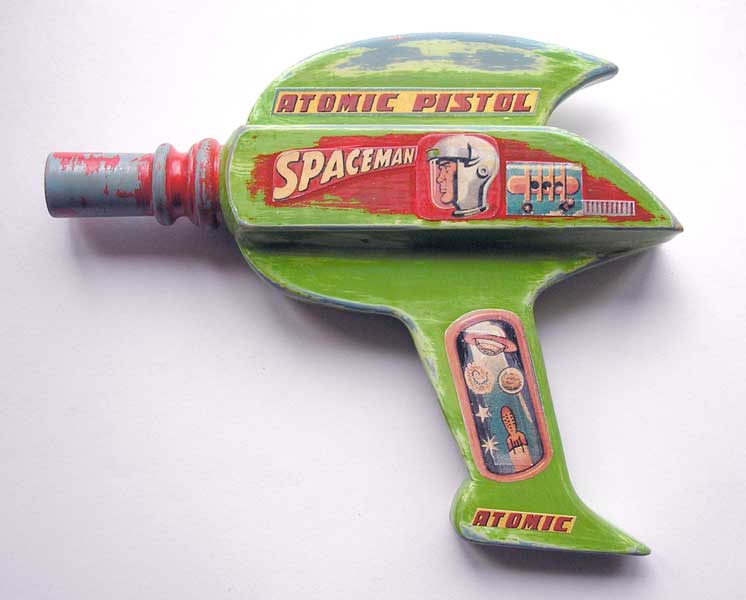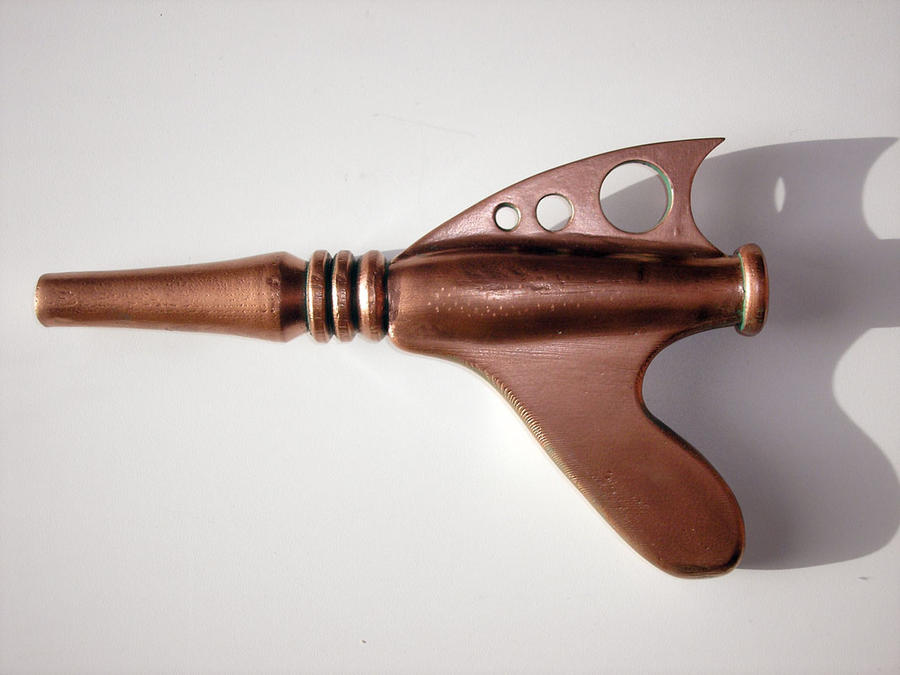Here are a few nice raygun pendants found on Etsy. Click the seller's name above each image to go their Etsy shop (and yes, these are all on my wishlist).
Bronze Ray Gun pendant by billyblue22 (this one is my very favourite, and I'll probably get around to buying myself one sooner or later):
Bronze Ray Gun Pendant by dragonstreasure (not as detailed as billyblue22's, but also not as expensive):
Admiral Forsythe's Hand Cannon wooden raygun pendant by buildersstudio (this crafter also makes nice ornaments and full-size rayguns, all of wood):
Hand-drawn, hand-coloured raygun necklace by sacredflesh (much more cheery and fun than the others):
Maybe I should try a raygun in my so-far-experimental project to make jewellery out of my not-to-be-reprinted intaglio plates . . .
Rayguns are not just the future. They're the retro-future. (The future updates irregularly.)
Sunday, October 3, 2010
Thursday, September 30, 2010
Raygun #6: Atomic Disintegrator (1/6 Scale)
Name: Atomic Disintegrator (1/6 scale)
Date: 2000s
Country: somewhere in Asia
Where Purchased: eBay
Cost: $9.99 plus shipping.
Notes: This is an adorable 1/6 scale version of the expensive and hard to find Hubley Atomic Disintegrator, in a gold-and-black colour scheme (the Hubley was silver with red hand grips). The little gun comes complete with an advertisement card and box (both with appealing retro graphics), and two tiny suction-cup darts that really do fit into the barrel of the gun (the orginal Hubley had no darts, being a capgun). The seller had a few other miniature rayguns, but I chose this one because of the box (and the fact that it's a Hubley). These haven't turned up in my recent raygun eBay searches, so I fear the seller may have vanished. Too bad, because I'd buy a few more.
Saturday, September 25, 2010
Zap! Raygun Classics Review

After a brief introduction about the nostalgia of rayguns, Singer delivers a lot of really nice pictures. The book is divided into sections by decade, starting with the 1930s and ending with the 1980s (which seems too recent to be properly vintage to me, but it was longer ago than I'd like to think). Most of the rayguns pictured get a half-page or a whole-page photograph with a small block of text identifying the name of the gun, the manufacturer and location, and the date (often only identified to the decade). Interspersed here and there with the rayguns are related items like robots, badges and vintage graphics.
The photographs are top-notch and the subjects--the rayguns themselves--are not all pristine examples, but often have dings, scratches and other evidence that they were once cherished playthings. The book closes with a brief bibliography (there just aren't that many resources for toy rayguns) and a price list, which is surprisingly accurate for something that's twenty years out of date.
This is a great volume for a coffee-table book. It doesn't really have enough information to make it useful as a reference source (though I've used sparser sources), but it invites flipping through over and over again. It's long out of print, but shouldn't be too difficult to find used.
Click here to buy Zap! Raygun Classics from Amazon.com
Thursday, September 23, 2010
Raygun #5: Atomic Space Gun
Name: Atomic Space Gun
Date: 1950s
Country: Japan
Where Purchased: eBay
Cost: Around $10 plus shipping.
Notes: Tin with litho illustrations. Intended to spark, but needs a new flint. Definitely got played with, but isn't in bad shape. This is the same gun pictured on page 33 of Zap! Raygun Classics by Leslie Singer (San Fransisco: Chronicle Books: 1991) with one small difference: mine has only yellow and white graphics, lacking the red shading on the text and the nucleus in the atomic symbol.
Date: 1950s
Country: Japan
Where Purchased: eBay
Cost: Around $10 plus shipping.
Notes: Tin with litho illustrations. Intended to spark, but needs a new flint. Definitely got played with, but isn't in bad shape. This is the same gun pictured on page 33 of Zap! Raygun Classics by Leslie Singer (San Fransisco: Chronicle Books: 1991) with one small difference: mine has only yellow and white graphics, lacking the red shading on the text and the nucleus in the atomic symbol.
Sunday, September 19, 2010
Raygun #4: Space Gun
Name: Space Gun
Date: Unknown. Described by seller as new old stock (ie. brand new and mint, but stored for many years in a warehouse), but quite likely a contemporary replica.
Country: Japan
Where Purchased: eBay
Cost: I think ten bucks plus shipping, but I don't recall.
Notes: Tin with litho illustrations. Sparks. The box has a UPC label and a label that says "COLLECTABLE ITEM NOT FOR CHILDREN ! AGES 8 AND UP" which is what makes me suspect it's a new replica and not an actual vintage item. Also, the box graphics are printed on a separate label and applied to the box, rather than being directly printed on the box. Still, a nice-looking raygun with fantastic 3-colour graphics on the box.
Date: Unknown. Described by seller as new old stock (ie. brand new and mint, but stored for many years in a warehouse), but quite likely a contemporary replica.
Country: Japan
Where Purchased: eBay
Cost: I think ten bucks plus shipping, but I don't recall.
Notes: Tin with litho illustrations. Sparks. The box has a UPC label and a label that says "COLLECTABLE ITEM NOT FOR CHILDREN ! AGES 8 AND UP" which is what makes me suspect it's a new replica and not an actual vintage item. Also, the box graphics are printed on a separate label and applied to the box, rather than being directly printed on the box. Still, a nice-looking raygun with fantastic 3-colour graphics on the box.
Thursday, September 16, 2010
The Raygun Art of Martin Gibbins
Apologies for the day-late post (again!). Life has been weird lately. But never mind, on to the good stuff.
I like to put interesting words in the search box of deviantArt and see what images crop up. I regularly search for things like "fox" or "airship" or "raygun" (hmm, is it "raygun" or "ray gun"?). Every now and then I'll share some of my finds here. Like this one. Martin Gibbins (gibsart on dA) is an artist in Ireland who paints and makes sculptures of robots, rayguns and other cool things.
The rayguns are assembled from found objects, like No. 1, above, or sculpted from wood and painted, like No. 3, below.
Anyway, go explore gibsart's gallery on deviantArt and his portfolio, and see the other cool stuff for yourself.
I like to put interesting words in the search box of deviantArt and see what images crop up. I regularly search for things like "fox" or "airship" or "raygun" (hmm, is it "raygun" or "ray gun"?). Every now and then I'll share some of my finds here. Like this one. Martin Gibbins (gibsart on dA) is an artist in Ireland who paints and makes sculptures of robots, rayguns and other cool things.
(Above: Raygun No. 1)
The rayguns are assembled from found objects, like No. 1, above, or sculpted from wood and painted, like No. 3, below.
(Above: Raygun No. 3)
Anyway, go explore gibsart's gallery on deviantArt and his portfolio, and see the other cool stuff for yourself.
(Above: Raygun No. 6)
Saturday, September 11, 2010
Raygun #3: Superior Laser Gun
Name: Superior Laser Gun
Date: Unknown, but purchased in 2009
Country: Unknown, but probably China
Where Purchased: Dollar store in Scotia Square (which now seems to be gone), Halifax, NS
Cost: $2 + tax
Notes: Pulling the trigger produces both a sound and some lovely old-fashioned sparks (which is why it was in the $2 section of the dollar store, I imagine). There don't seem to be any maker's marks moulded in the plastic. The stickers say "Laser Gun" "SUPER POWER 2000" "A HUNDRED SHOTS" "SUPERIOR" and "LASER GUN" and have a picture of the Space Shuttle attacking a Death Star/R2D2 hybrid. I love it just for the image alone.
Thursday, September 9, 2010
Future Perfect: Book Review

And sturdiness is a must for this book because, although it has very little text (just a three-page introduction by Bruce McCall, in three languages), the images invite frequent browsing. The whole book (except the introduction, and images that were originally black and white) is in full-colour and the reproduction--as is usual for Taschen books--is fantastic. Every halftone dot is visible and wrinkles and tears in the original images can be spotted here and there. The images themselves come from sources like Popular Science and Modern Mechanix and Inventions and include cover art, illustrations and advertisements. One of my few criticisms of this book is that none of the images have information about where they came from, or even their date (except, of course, the ones that show the whole cover of a magazine). That's not a problem if you just want to enjoy the pictures, but if you want to actually do some research, it becomes a very big problem.
My only other criticism is that many of the images are cropped, and there's no way to tell how much of the image has been left out. OK, one more: it would be nice if the book were physically larger, but then it would have to be correspondingly more expensive.
Overall, I'm delighted with Future Perfect. It's a great reference for getting a feel for the raygun gothic style and fun to flip through and think about how enthusiastic we were for the future to come. If only each image had a provenance (even just a list at the back of the book), it would be nearly, um, perfect. I'm not going to complain, though. Someone left the book lying abandoned at my old art school, so I got it free (I'd have bought it in a bookstore, though, if I hadn't).
Click here to buy Future Perfect from Amazon.com
Sunday, September 5, 2010
Raygun #2: HH Dream
Name: HH Dream
Date: Unknown, but purchased in 2009
Country: China
Where Purchased: Dollar store in Scotia Square (which now seems to be gone), Halifax, NS
Cost: $1 + tax
Notes: There's an oval molded in the plastic just above the sticker (which is a little sun-faded as I had it near a window) that says "HUA HAI." Near the front it has the molded mark "No. 600 MADE IN CHINA." It's a double-barreled water gun, but I haven't actually tried it to see if both barrels fire. I can feel air coming out of the top one when I squeeze the trigger, but not the bottom one (though it does have a hole for the water).
Wednesday, September 1, 2010
The Wonders of the World, Circa 1938
At a charity book sale last year I found this great little book from 1938, for the princely sum of one dollar (Canadian):
Wonders of the World! In 1938, the Wonders of the World included all the usual suspects like the pyramids of Giza, Stonehenge and the Colossus of Rhodes. All the ones that still existed at the time are represented by lovely black and white photographs; those that didn't are depicted in illustrations.
But in 1938, the wonders of the world included much more than just the Seven Wonders of the Ancient World and the Seven Wonders of the Medieval World. They also included more recently-discovered (to Europeans) natural Wonders like Carlsbad Caverns, Old Faithful, and Yosemite Falls.
And they included technological and architectural Wonders, like the Empire State Building:
The New York skyline is also a Wonder, as are the Queen Mary, Boulder Dam, the George Washington Bridge, and the Golden Gate Bridge.
Transportation, too, could be a Wonder. Shining examples include Modern Streamlined Trains:
And the China Clipper:
The enthusiasm for technology and greater things to come in the future that's expressed in the book is infectious. I find flipping through it delightful, and it makes an interesting document of what people thought of the world in the 30s.
Wonders of the World! In 1938, the Wonders of the World included all the usual suspects like the pyramids of Giza, Stonehenge and the Colossus of Rhodes. All the ones that still existed at the time are represented by lovely black and white photographs; those that didn't are depicted in illustrations.
But in 1938, the wonders of the world included much more than just the Seven Wonders of the Ancient World and the Seven Wonders of the Medieval World. They also included more recently-discovered (to Europeans) natural Wonders like Carlsbad Caverns, Old Faithful, and Yosemite Falls.
And they included technological and architectural Wonders, like the Empire State Building:
The New York skyline is also a Wonder, as are the Queen Mary, Boulder Dam, the George Washington Bridge, and the Golden Gate Bridge.
Transportation, too, could be a Wonder. Shining examples include Modern Streamlined Trains:
And the China Clipper:
The enthusiasm for technology and greater things to come in the future that's expressed in the book is infectious. I find flipping through it delightful, and it makes an interesting document of what people thought of the world in the 30s.
Saturday, August 28, 2010
Raygun #1
Name: ?
Date: Purchased in 2009, don't know when it was made
Country: Probably made in China, but the only markings I can find on it say "1010 LAN WEI," and I've mislaid the packaging
Where Purchased: Dollar store in Scotia Square (which now seems to be gone), Halifax, NS
Cost: $1 + tax
Notes: Made of dark coloured plastic with an oil-slick iridescent finish. There's an LED inside, but it doesn't light up (probably dead battery or broken connection--I'm going to open it up and see if I can figure it out). The shape reminds me a bit of a Star Wars blaster.
Wednesday, August 25, 2010
A Definition and a Mission Statement
Raygun Gothic, Defined
Googie/Populuxe/Streamline Moderne/Art Deco architecture (and, in general, style) in retro-futuristic science fiction. "A tomorrow that never was," says Lance Olsen. This is the style of the Atomic Age (atompunk, if you must) and the term was coined by the fantastic William Gibson (through one of his characters) in his story "The Gernsback Continuum." Another character in the same story used the term "American Streamlined Modern."
Raygun Gothic, Mission Statement
I first thought of starting this blog as a way to catalogue my raygun collection, in the hopes that other people might find it useful, or at least think the pictures are cool. And I will do that here. But I also want to showcase some of the very cool raygun art people are making and selling (much of which I, sadly, can't afford to add to my collection). And I'll review the odd book.
But in addition, partly spurred by a blog post by writer Philip Reeve (go read his Hungry City/Mortal Engines books, and find him on Twitter as philipreevebks), I want to write about the whole Raygun Gothic style (do I need to keep capitalizing that, I wonder? It could get tiresome), not just as it appears in science fiction, but also as it manifested in real life. The architecture, the crazy 1930s stunt aircraft, the streamlined locomotives of the 30s, 40s and 50s, and so on, and so on.
What Reeve said was (in small part):
If you make art that fits the style--especially if you make rayguns--send me an email (or if you can't find my address, leave a comment). I'd love to feature you.
Googie/Populuxe/Streamline Moderne/Art Deco architecture (and, in general, style) in retro-futuristic science fiction. "A tomorrow that never was," says Lance Olsen. This is the style of the Atomic Age (atompunk, if you must) and the term was coined by the fantastic William Gibson (through one of his characters) in his story "The Gernsback Continuum." Another character in the same story used the term "American Streamlined Modern."
Raygun Gothic, Mission Statement
I first thought of starting this blog as a way to catalogue my raygun collection, in the hopes that other people might find it useful, or at least think the pictures are cool. And I will do that here. But I also want to showcase some of the very cool raygun art people are making and selling (much of which I, sadly, can't afford to add to my collection). And I'll review the odd book.
But in addition, partly spurred by a blog post by writer Philip Reeve (go read his Hungry City/Mortal Engines books, and find him on Twitter as philipreevebks), I want to write about the whole Raygun Gothic style (do I need to keep capitalizing that, I wonder? It could get tiresome), not just as it appears in science fiction, but also as it manifested in real life. The architecture, the crazy 1930s stunt aircraft, the streamlined locomotives of the 30s, 40s and 50s, and so on, and so on.
What Reeve said was (in small part):
The idea for all this first occurred to me some years ago: I was still writing the Larklight books then, and I spent a pleasant afternoon plotting out a sort of Larklight:The Next Generation, which would swap all the Victorian motifs for Dan Dare ones. Having done so, however, I didn't want to spend six months actually writing the thing, so I'm passing the notion on to anyone who's interested. Strap on your jet-pack and rocket boots and set a course for the Lunar Academy: you could become the JK Rowling of the Jet Age!I'm not quite ready to tackle another novel yet (I still have a couple to finish before I start something new), but I think I can do this blog.
If you make art that fits the style--especially if you make rayguns--send me an email (or if you can't find my address, leave a comment). I'd love to feature you.
Subscribe to:
Posts (Atom)
